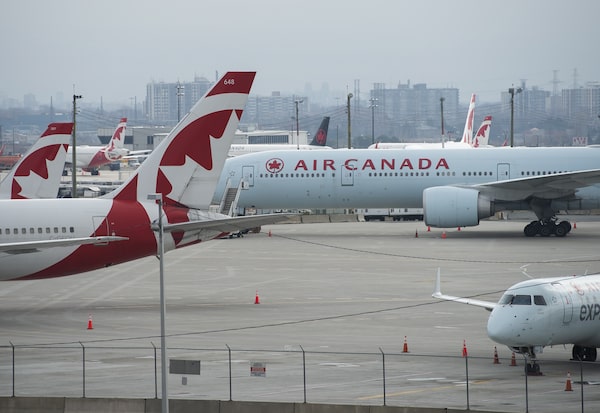
Air Canada planes sit on the tarmac at Pearson International Airport in Toronto on April 8, 2020.Nathan Denette/The Canadian Press
Air Canada will lay off more than half of its 38,000 employees next month as it grapples with the fallout from the COVID-19 pandemic.
The layoffs, which will take place June 7, will affect a minimum of 19,000 staff and could go as high as 22,800.
The country’s largest airline – along with its competitors – has seen demand for air travel evaporate amid ongoing border shutdowns and confinement measures, prompting Air Canada to ground some 225 airplanes and slash flight capacity by 95 per cent.
“We therefore took the extremely difficult decision today to significantly downsize our operation to align with forecasts, which regrettably means reducing our work force by 50 to 60 per cent,” the airline said in an e-mail Friday evening. “We estimate about 20,000 people will be affected.”
The airline made a similar decision in March to let go of nearly half of its work force under a cost reduction scheme, only to rehire some 16,500 laid-off flight attendants, mechanics and customer service agents in April under the Canada Emergency Wage Subsidy – a program it has not committed to participate in past June 6.
To minimize the number of layoffs, Air Canada will ask flight attendants to slash their schedules, go on leave for up to two years or resign with travel privileges, according to an internal bulletin to members from the Canadian Union of Public Employees sent out Thursday night and obtained by The Canadian Press.
The memo states that CUPE is in discussions with Air Canada over continuing the federal wage subsidy.
“We know this news is not what any of us were expecting,” states the bulletin, signed by the president of CUPE’s Air Canada component and two other union officials.
“The reality is that COVID-19 has severely impacted the demand for air travel over the past few months and into the foreseeable future. As such, there is no denying that we are dealing with the largest surplus of cabin personnel in our history.”
Air Canada did not respond directly to questions about whether it would exit the wage subsidy program, which Ottawa recently extended through August.
The subsidy program that allowed employees – including 6,800 flight attendants – to be rehired last month covers 75 per cent of a worker’s normal hourly wages or up to $847 per week. The vast majority of those workers have stayed at home, however, as operations remain at a virtual standstill.
While Air Canada is not currently contributing to most worker wages, the airline has continued to pay into its pensions and benefits funds, a continuous cash drain at a company that lost more than $1 billion last quarter.
The Montreal-based company has been bleeding cash since mid-March and expects even fewer passengers between April and June.
Though traffic is expected to pick up somewhat before year’s end, Air Canada CEO Calin Rovinescu said last week the recovery will be slow, with at least three years of subpar earnings.
Your time is valuable. Have the Top Business Headlines newsletter conveniently delivered to your inbox in the morning or evening. Sign up today.